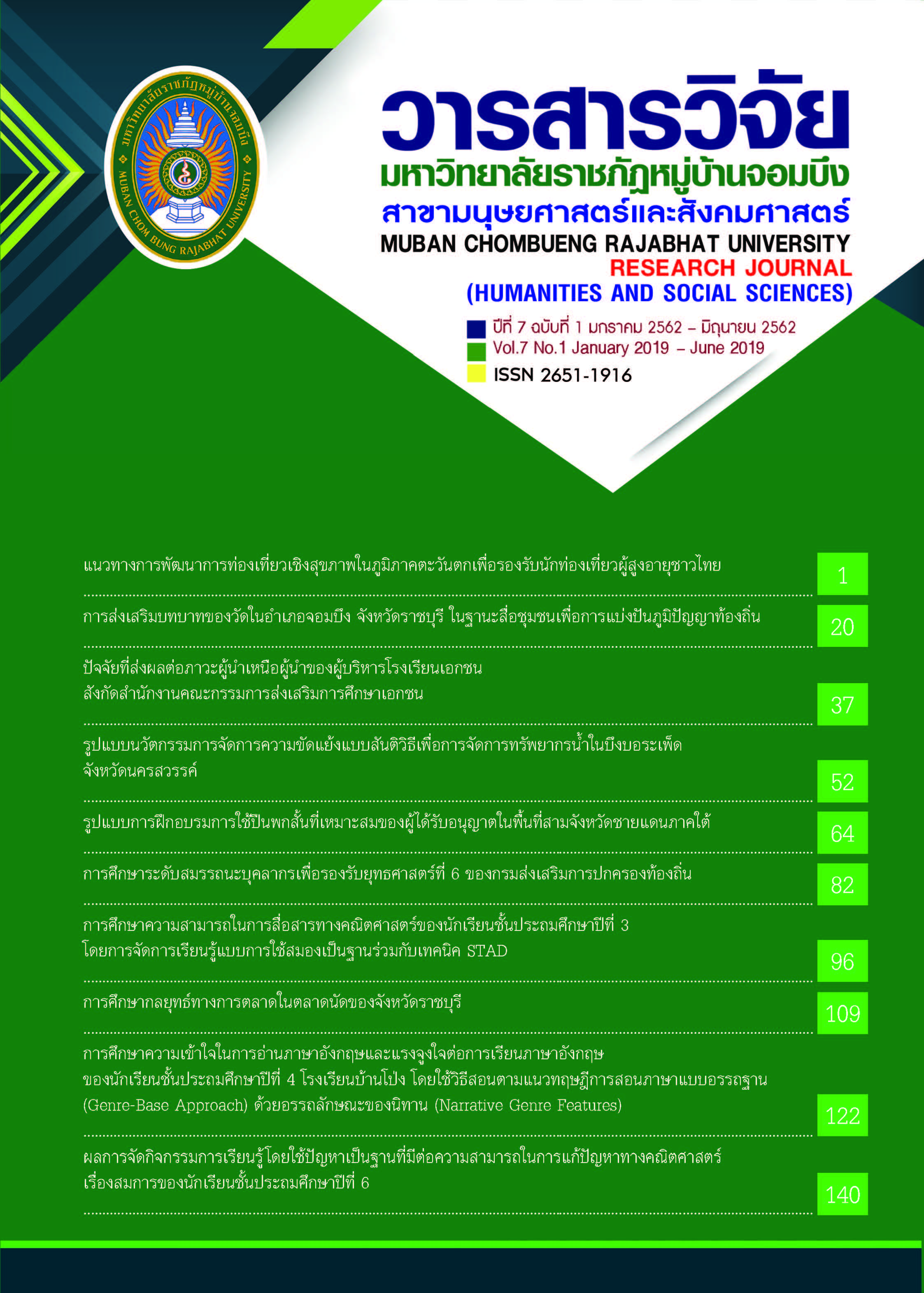การศึกษาความสามารถในการสื่อสารทางคณิตศาสตร์ ของนักเรียนชั้นประถมศึกษาปีที่ 3 โดยการจัดการเรียนรู้แบบการใช้สมองเป็นฐานร่วมกับเทคนิค STAD
คำสำคัญ:
การจัดการเรียนรู้แบบการใช้สมองเป็นฐาน, เทคนิค STAD, ความสามารถในการสื่อสารทางคณิตศาสตร์บทคัดย่อ
การวิจัยครั้งนี้มีวัตถุประสงค์เพื่อ 1) เปรียบเทียบความสามารถในการสื่อสารทางคณิตศาสตร์ ของนักเรียนชั้นประถมศึกษาปีที่ 3 ก่อนและหลังได้รับการจัดการเรียนรู้แบบการใช้สมองเป็นฐานร่วม กับเทคนิค STAD และ 2) เปรียบเทียบความสามารถในการสื่อสารทางคณิตศาสตร์ ของนักเรียนชั้นประถมศึกษาปีที่ 3 หลังได้รับการจัดการเรียนรู้แบบการใช้สมองเป็นฐานร่วมกับเทคนิค STAD กับเกณฑ์ร้อยละ 70 ของคะแนนเต็ม กลุ่มตัวอย่าง คือ นักเรียนชั้นประถมศึกษาปีที่ 3 โรงเรียนอนุบาลวัดนางใน (ละเอียดอุปถัมภ์) สังกัดสำนักงานเขตพื้นที่การศึกษาประถมศึกษาอ่างทอง ซึ่งกำลังศึกษาอยู่ในภาคเรียนที่ 2 ปีการศึกษา 2561 จำนวน 46 คน ได้มาโดยการสุ่มแบบกลุ่มหลายขั้นตอน เครื่องมือที่ใช้ในการวิจัย ได้แก่ แผนการจัดการเรียนรู้แบบการใช้สมองเป็นฐานร่วมกับเทคนิค STAD จำนวน 20 แผน มีความเหมาะสมหรือสอดคล้องกันในระดับมากที่สุด และแบบทดสอบวัดความสามารถในการสื่อสารทางคณิตศาสตร์ มีค่าความเชื่อมั่น เท่ากับ 0.85 ค่าอำนาจจำแนก อยู่ระหว่าง 0.45-0.77 และค่าความยากง่าย อยู่ระหว่าง 0.25-0.75 สถิติที่ใช้ในการวิเคราะห์ข้อมูล ได้แก่ ค่าร้อยละ ค่าเฉลี่ย ค่าความเบี่ยงเบนมาตรฐาน และการทดสอบค่าที แบบ t-test for Dependent Samples และ t-test for One Sample
ผลการวิจัย พบว่า 1) ความสามารถในการสื่อสารทางคณิตศาสตร์ ของนักเรียนชั้นประถมศึกษาปีที่ 3 หลังได้รับการจัดการเรียนรู้แบบการใช้สมองเป็นฐาน ร่วมกับเทคนิค STAD สูงกว่าก่อนได้รับการจัดการเรียนรู้แบบการใช้สมองเป็นฐานร่วมกับเทคนิค STAD อย่างมีนัยสำคัญทางสถิติที่ระดับ 0.05 (t = 21.383) 2) ความสามารถในการสื่อสารทางคณิตศาสตร์ ของนักเรียนชั้นประถมศึกษาปีที่ 3 หลังได้รับการจัดการเรียนรู้แบบการใช้สมองเป็นฐานร่วมกับเทคนิค STAD สูงกว่าเกณฑ์ร้อยละ 70 ของคะแนนเต็ม อย่างมีนัยสำคัญทางสถิติที่ระดับ 0.05 (t = 6.915)
เอกสารอ้างอิง
กระทรวงศึกษาธิการ. (2551). หลักสูตรแกนกลางการศึกษาขั้นพื้นฐาน พุทธศักราช 2551. กรุงเทพฯ: โรงพิมพ์ชุมนุมสหกรณ์การเกษตรแห่งประเทศไทย จำกัด.
ชฎาภรณ์ สงวนแก้ว. (2551). การจัดการเรียนรู้สองสถานะ Dual Mode Learning Mangement, สืบค้นเมื่อ 24 สิงหาคม 2561, จาก http://www.patai.ac.th/files/ Dual-Mode School-20081023.pdf.
ชูศรี วงศ์รัตนะ. (2553). เทคนิคการใช้ สถิติเพื่อการวิจัย (พิมพ์ครั้งที่ 12). นนทบุรี: ไทเนรมิตกิจ อินเตอร์ โปรเกรสซิฟ.
ระบบสารสนเทศเพื่อบริหารการศึกษา. (2561). ข้อมูลนักเรียนชั้นประถมศึกษาปีที่ 3 ปีการศึกษา 2561 ของสำนักงานเขตพื้นที่การศึกษาประถมศึกษาอ่างทอง. สืบค้นเมื่อ 25 สิงหาคม 2561, จากhttps://data.bopp-obec.info/emis/student.php?Edu_year=2561& Area_CODE=1501.
เวชฤทธิ์ อังกนะภัทรขจร. (2554). เอกสารคำสอน วิชา 410541 ทักษะและกระบวนการทางคณิตศาสตร์. ชลบุรี: ภาควิชาการจัดการเรียนรู้ คณะศึกษาศาสตร์ มหาวิทยาลัยบูรพา.
สำนักงานทดสอบทางการศึกษาแห่งชาติ. (2560). ประกาศผลสอบ NT ชั้นประถมศึกษาปีที่ 3. กรุงเทพฯ: สถาบันพัฒนาคุณภาพวิชาการ.
อัจฉราพรรณ อาโน. (2555). การจัดการเรียนรู้แบบกลุ่มร่วมมือเทคนิค STAD เพื่อพัฒนาทักษะการสื่อสารทางคณิตศาสตร์ของนักเรียนชั้นประถมศึกษาปีที่ 5. วิทยานิพนธ์ครุศาสตร มหาบัณฑิต, สาขาหลักสูตรและการสอน คณะครุศาสตร์ มหาวิยาลัยราชภัฏเชียงราย.
Caine, R. N., & Caine, G. (1990). Understanding a brain based approach to learning and teaching. Educational Leadership, 48(2), 66-70.
Jensen, E. (2000). Brain-based learning. San Diego, CA: The Brain Store Publishing.
Tinungki, & Georgina, M. (2015). The Role of Cooperative Learning Type Team Assisted Individualization to Improve the Students' Mathematics Communication Ability in the Subject of Probability Theory. Journal of Education and Practice. 6(32), 27-31.
ดาวน์โหลด
เผยแพร่แล้ว
รูปแบบการอ้างอิง
ฉบับ
ประเภทบทความ
สัญญาอนุญาต
วารสาร TCI อยู่ภายใต้การอนุญาต Creative Commons Attribution-NonCommercial-NoDerivatives 4.0 International (CC BY-NC-ND 4.0) เว้นแต่จะรุบุไว้เป็นอย่างอื่นโปรดอ่านหน้านโยบายของเราสำหรับข้อมูลเพิ่มเติมเกี่ยวกับการเช้าถึงแบบเปิด ลิขสิทธิ์ และการอนุญาต



